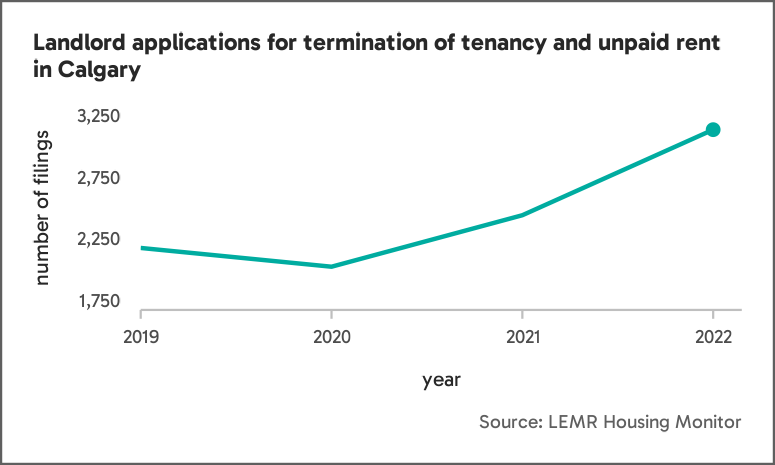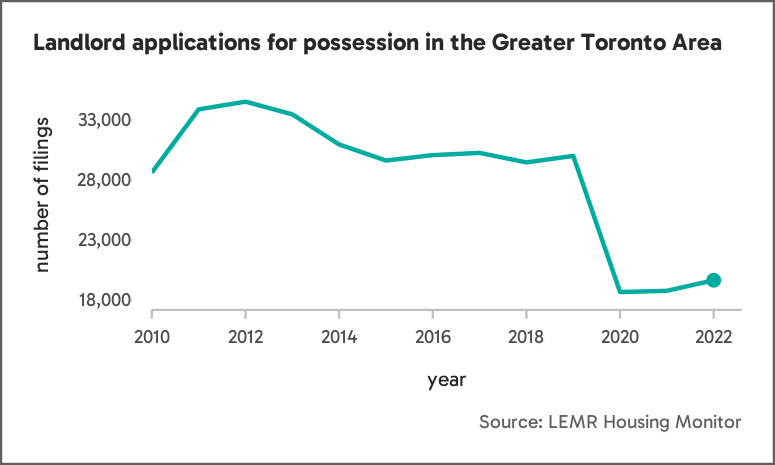Records relevant to eviction proceedings were obtained via Freedom of Information requests for the LEMR Housing Monitor in Calgary, Vancouver, Toronto, Winnipeg, and Halifax. Below we highlight several trends we observed in these filings over time in each region, as well as details on how institutions vary in the data they collect.
It is important to note that these records refer to eviction-relevant legal proceedings which typically result from a dispute between a landlord and a tenant. These records do not include, for example, evictions in which the tenant vacated the residence without going to court.
Read our Data Definitions for information about the sources of these records.
Calgary
In Calgary, we obtained eviction records related to landlord applications made to Alberta’s Residential Tenancy Dispute Resolution Service for termination of tenancy and unpaid rent. Overall, these data showed a slight decrease in landlord applications between 2019 and 2020 followed by an upward trajectory.

Vancouver
In Vancouver, we obtained eviction records related to applications made to British Columbia’s Residential Tenancies Branch in which a landlord was seeking to take possession of a rental unit. These data showed several periods between 2007 and 2022 where a sharp decline was followed by a sharp increase.

Greater Toronto Area
In the Greater Toronto Area, we obtained eviction records related to the following landlord applications made to Ontario’s Landlord and Tenant Board:
- L1: Application to evict a tenant for non-payment of rent and to collect rent the tenant owes.
- L2: Application to end a tenancy and evict a tenant or collect money.
- L3: Application to end a tenancy – tenant gave notice or agreed to terminate the tenancy.
- L4: Application to end a tenancy and evict a tenant – tenant failed to meet conditions of a settlement or order.
Sometimes records include more than one application. Cases that included at least one L1, L2, L3, or L4 were included in our analysis. Overall, these data show a downward trend between 2010 and 2022.

Winnipeg
In Winnipeg, we obtained eviction records related to Orders of Possession that were requested either for unpaid rent or for other reasons. Overall, these data show a general upward trajectory in filings with Manitoba’s Residential Tenancies Branch between 2006 and 2022.

Halifax
In Halifax, we obtained eviction records related to the following applications at Nova Scotia’s Residential Tenancies Program:
- Form J: Apply to the Director of Residential Tenancies to resolve a dispute between a landlord and tenant.
- Form K: Apply to the Director of Residential Tenancies to end a tenant’s lease because of unpaid rent without participating in a hearing or mediation with the tenant.
These data differ from the other provinces in that Form J may be used by a landlord or a tenant for a variety of issues, including disputes over evictions, or the return of a security deposit. Form K, in contrast, is used exclusively by landlords, but only represent a subset of eviction filings in which the reason for eviction is unpaid rent and the landlord wishes to proceed without a hearing or attempt to mediate with the tenant. The landlord cannot file a Form K if the tenant filed a Form J or if the landlord wishes to receive additional compensation, such as compensation for damages. These data show a slight increase in Form K filings over time. Form J filings showed a sharp decrease in 2020, followed by a sharp increase.

Conclusion
Provincial differences in the processing of eviction filings make direct comparison across regions imperfect. Nonetheless, the differences across regions shown above indicate that eviction filings do not follow a uniform trajectory. Rather, regions differ, sometimes dramatically, in eviction filing trends, pointing to the need to evaluate housing issues from both broad systemic and local perspectives.
